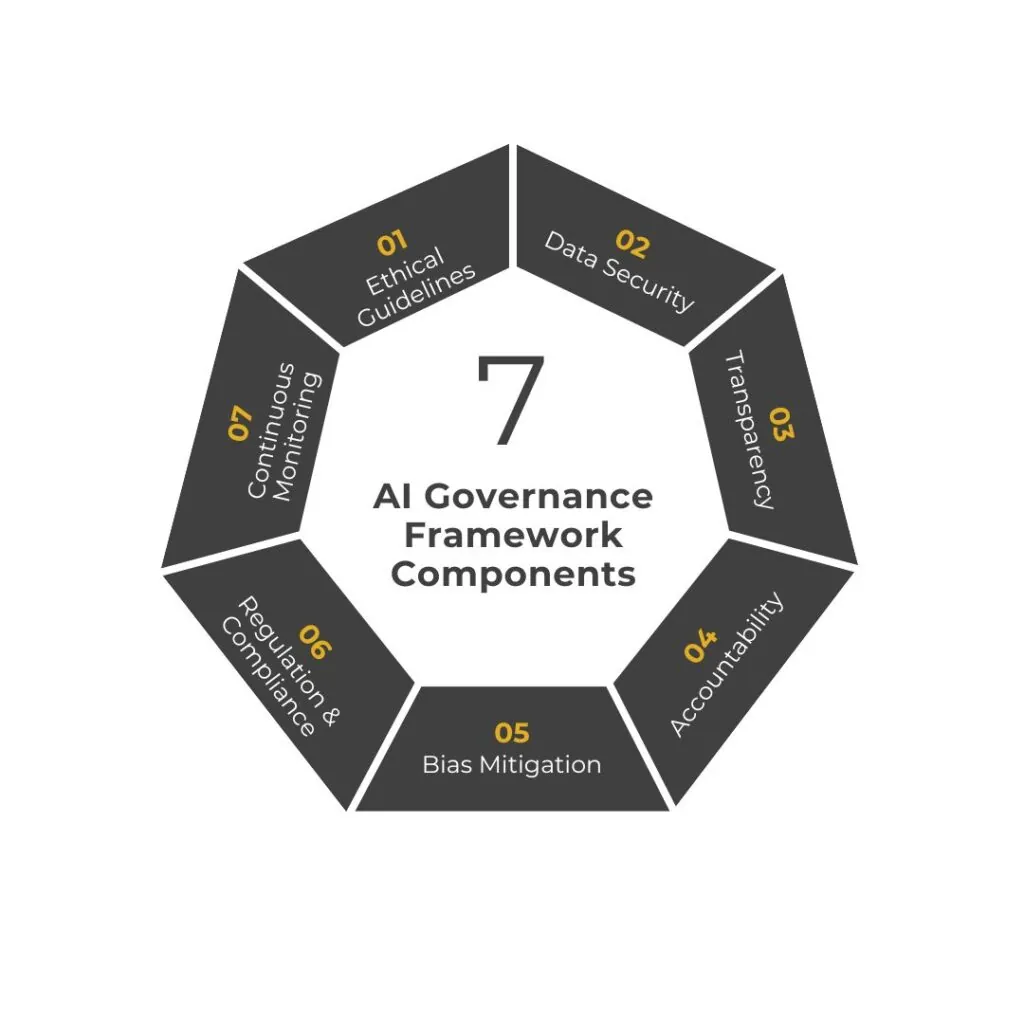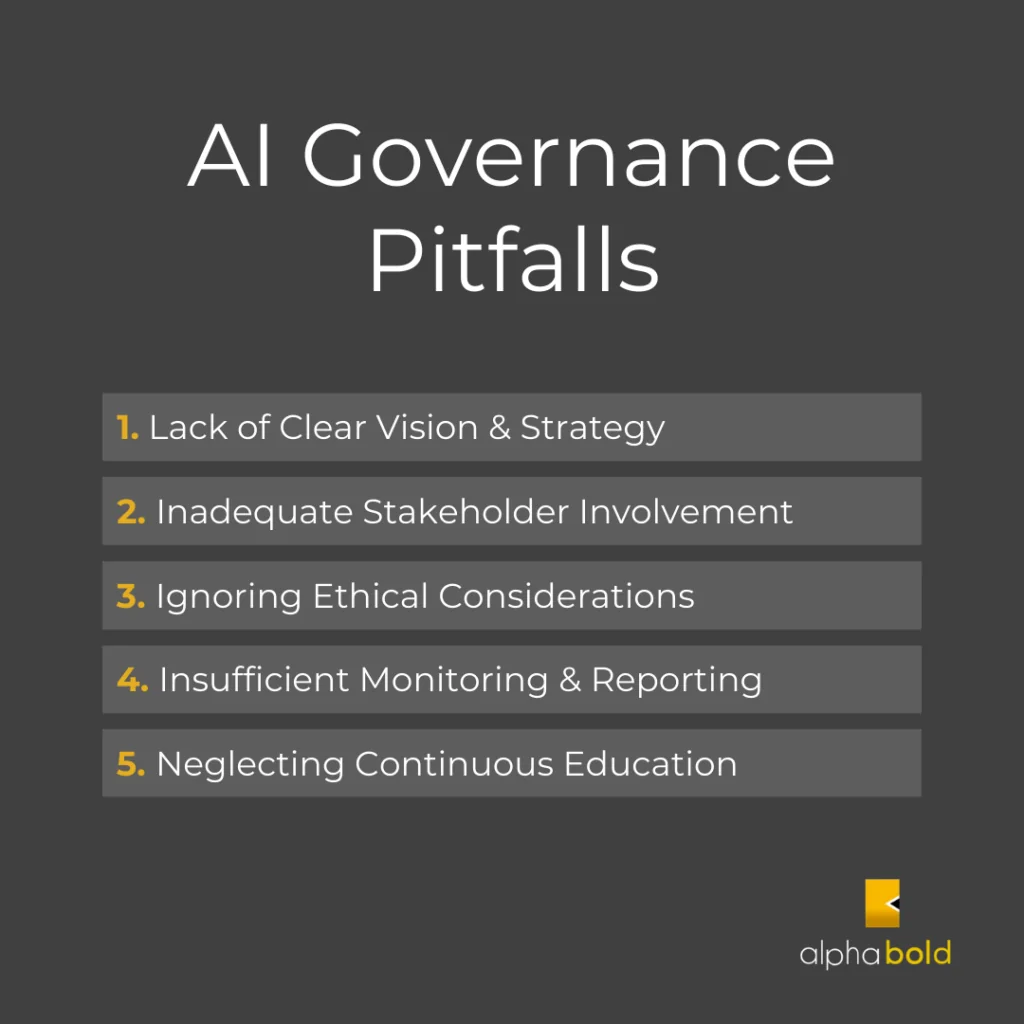Artificial Intelligence (AI) is quickly altering industries, automating procedures, and improving the way we connect. From revolutionizing customer service with chatbots to optimizing supply chains with predictive analytics, AI’s applications are vast and varied. However, as AI becomes increasingly integrated into our daily lives, it brings with it a host of ethical, legal, societal, and organizational implications that must be carefully managed.
As Gartner states, “By 2025, AI will be a top investment priority for more than 30% of CIOs, but without proper governance frameworks, organizations may face significant ethical and operational risks.”
However, the integration of AI into business operations comes with many risks. Potential issues such as privacy violations, biased algorithms, and the misuse of AI for malicious purposes are significant concerns. Without proper oversight, these risks can lead to severe consequences, including loss of customer trust, legal repercussions, and harm to an organization’s reputation.
Establishing a robust AI governance framework is essential to mitigate these risks. Such a framework ensures transparency in AI processes, holds stakeholders accountable, and promotes the responsible development and deployment of AI systems. By employing clear standards, policies, and regulations businesses can protect themselves against potential hazards and utilize AI’s capabilities to drive innovation.
At AlphaBOLD, we understand the critical importance of AI governance in today’s business landscape. Our commitment to excellence in AI implementation is reflected in our comprehensive eBook, “Preparing Your Business for an AI Implementation: The Ultimate Checklist.” This resource provides detailed guidance on establishing effective AI governance frameworks, helping businesses navigate the complexities of AI deployment responsibly and ethically.
To establish ethical guidelines, organizations must define universal principles and values that ensure fairness, transparency, accountability, and privacy. Fairness involves ensuring that AI systems operate without bias and provide equitable outcomes for all users. Transparency requires clearly communicating how AI models function, including data sources, decision-making processes, and intended uses. Accountability holds AI developers and operators responsible for their systems’ actions and decisions. Privacy protections involve implementing robust measures to safeguard users’ personal data and ensuring that data is used ethically.
Implementing data privacy and security measures is crucial for protecting sensitive information. This begins with obtaining explicit consent from users for data collection, storage, and sharing. Data encryption should be used to secure data both at rest and in transit, while access controls restrict data access to authorized personnel only and implement multi-factor authentication. Regular data security audits are necessary to identify and rectify vulnerabilities, ensuring continuous protection against data breaches.
Maintaining transparency involves clarifying the AI model’s purpose and operations. Organizations should provide detailed documentation on the AI model’s objectives, data collection methods, and processing activities. User communication should be clear and user-friendly, explaining how AI systems work and their decision-making processes. Additionally, where feasible, organizations should consider open-sourcing parts of their AI models to foster transparency and build community trust.
Demonstrating accountability requires establishing clear guidelines for responsibility within AI governance. This includes defining roles and responsibilities for AI governance within the organization and developing a framework to address liability issues arising from AI decisions and actions. Implementing a system for reporting and addressing AI-related incidents or errors ensures that any negative impacts are promptly addressed and rectified.
Establishing continuous monitoring and assessment mechanisms ensures the ongoing reliability and effectiveness of AI systems. Performance tracking tools should be implemented to monitor AI system performance and outcomes continuously. Regular risk assessments assist in identifying possible liabilities and improvement areas. Creating feedback loops to collect user input and improve AI models is fundamental for adjusting to growing needs. Periodic reviews of AI systems ensure they remain effective and compliant with changing standards and expectations.
By integrating these components into their AI governance frameworks, organizations can promote ethical and responsible AI deployment, mitigating risks while maximizing the benefits of AI technologies.
Implementing an AI governance framework is a multi-faceted process that requires strategic planning, collaboration, and continuous improvement. By following a structured approach, organizations can ensure that their AI systems are developed and utilized ethically, responsibly, and in compliance with legal standards. The following steps provide a roadmap for building an effective AI governance framework, helping businesses to harness the power of AI while mitigating potential risks.
Defining your AI vision and strategy is essentially the first step in constructing an AI governance framework.This involves aligning AI initiatives with your overall business goals and involving key stakeholders in the process. By creating a comprehensive roadmap for AI implementation, you ensure that AI projects are strategically planned and executed to support your organization’s objectives. Engaging stakeholders from various departments helps in understanding different perspectives and requirements, ensuring a well-rounded approach to AI integration.
Establishing a governance team is crucial for overseeing AI initiatives. Identify cross-functional team members who bring diverse expertise to the table and define clear roles and responsibilities. Ensure representation from IT, legal, compliance, and business units to cover all aspects of AI governance. This team will be responsible for developing policies, monitoring AI systems, and ensuring compliance with regulatory standards. A well-defined governance structure helps in maintaining accountability and streamlining decision-making processes.
Developing comprehensive policies and guidelines is essential for guiding the ethical and secure use of AI. Create and regularly update policies for data privacy, ethical AI use, and security to reflect evolving standards and regulations. Establish clear guidelines for AI model development, testing, and deployment to ensure consistency and reliability. Regular policy reviews and updates are necessary to keep pace with technological advancements and changing legal requirements, helping your organization stay compliant and ethical in its AI practices.
Continuous training and education are vital for keeping your team informed and skilled in AI governance. Offer continuous training for employees on AI ethics, data handling, and governance practices. Promote a culture that values ongoing learning and improvement, ensuring staff can effectively respond to emerging challenges and advancements in AI technology. Well-trained employees are better equipped to manage AI systems responsibly and effectively, reducing the risk of ethical and operational issues.
Fostering an ethical AI culture within your organization is key to ensuring responsible AI use. Promote ethical AI practices by encouraging open discussions about AI-related concerns and dilemmas. Establish a whistleblower policy that allows employees to report unethical AI practices without fear of retaliation. Creating an environment where ethical considerations are prioritized helps in building trust and accountability, ensuring that AI technologies are used for the benefit of all stakeholders.
By following these steps, organizations can build a robust AI governance framework that supports ethical, responsible, and effective AI deployment. This comprehensive approach not only mitigates potential risks but also maximizes the benefits of AI technologies, driving innovation and growth in a sustainable manner.
Implementing an AI governance framework is a complex endeavor, and even well-intentioned efforts can go awry without careful planning and execution. To help you navigate this process successfully, here are some common pitfalls to avoid:
A clear vision and strategy are paramount for any AI initiative. Without aligning AI projects with your business goals, you risk deploying technology that doesn’t serve your organizational objectives. Ensure your AI vision is well-defined and that all stakeholders understand and support the strategic direction. This alignment is crucial for integrating AI seamlessly into your business operations and achieving meaningful outcomes.
AI governance cannot be achieved in isolation. It requires cross-functional collaboration and buy-in from various departments, including IT, legal, compliance, and business units. Inadequate stakeholder involvement can lead to a lack of diverse perspectives, which is essential for identifying potential risks and ensuring comprehensive governance. Engage all relevant stakeholders early in the process to build a governance framework that addresses the needs and concerns of the entire organization.
Prioritize ethical considerations in AI governance to avoid biased systems and ensure transparency. Ignoring these issues can undermine trust and cause harm. Establish and follow ethical guidelines that emphasize fairness, accountability, and transparency. Regularly review and update these guidelines to reflect evolving ethical standards and societal expectations.
Continuous monitoring and reporting are vital to ensure AI systems perform as intended and remain compliant with regulations. Insufficient tracking can lead to unnoticed errors, biases, or breaches. Implement robust monitoring tools and define key performance indicators (KPIs) to regularly assess AI performance. This ongoing oversight helps in early detection of issues and allows for timely interventions.
AI technologies and governance practices are constantly evolving. Neglecting continuous education can leave your team unprepared to handle new challenges and advancements. Provide ongoing training for employees on AI ethics, data handling, and governance. Encourage a culture of continuous learning to ensure your team stays informed and skilled, enhancing their ability to manage AI responsibly and effectively.
Establishing a robust AI governance framework is not just a best practice; it’s a necessity in today’s rapidly evolving technological landscape. Such frameworks are crucial for mitigating risks, ensuring compliance, and fostering ethical AI deployment. They help organizations harness the full potential of AI while safeguarding against potential pitfalls like privacy violations, biased algorithms, and misuse of technology.
It’s essential for stakeholders to take proactive measures in establishing and maintaining AI governance frameworks. By being proactive, you ensure that your AI initiatives are aligned with business goals, ethical standards, and regulatory requirements. This proactive approach not only minimizes risks but also positions your organization as a leader in responsible AI usage.
A comprehensive AI governance framework brings numerous advantages. It promotes transparency and accountability, builds trust among stakeholders, and ensures ethical and responsible AI deployment. Moreover, well-governed AI systems are more likely to perform reliably, delivering meaningful insights and driving innovation and growth within your organization. By prioritizing AI governance, you set the stage for sustainable success in the era of artificial intelligence.
By avoiding common pitfalls and embracing the outlined steps, your organization can build a robust AI governance framework that supports ethical, responsible, and effective AI deployment. This comprehensive approach not only mitigates potential risks but also maximizes the benefits of AI technologies, driving innovation and growth in a sustainable manner.








